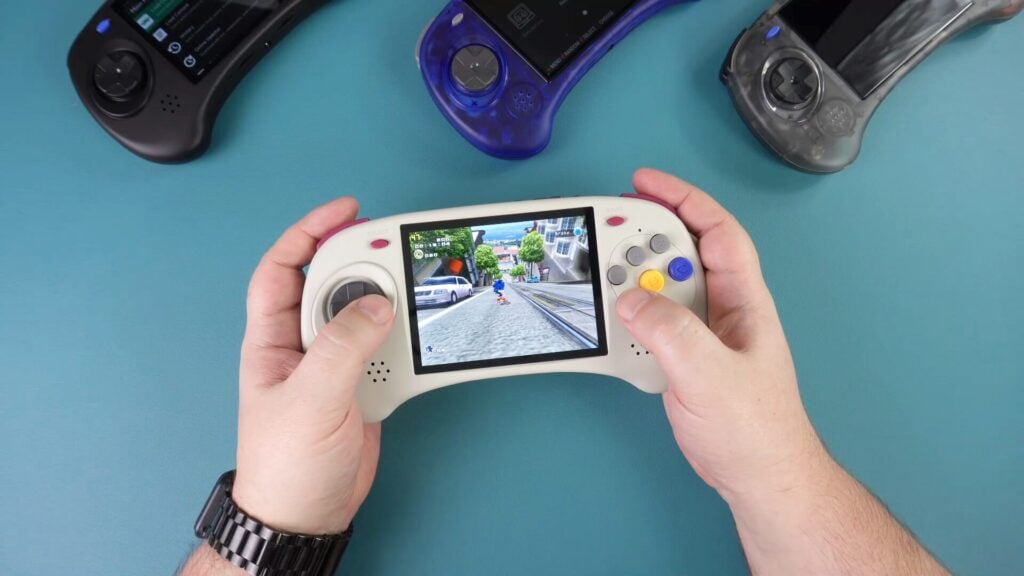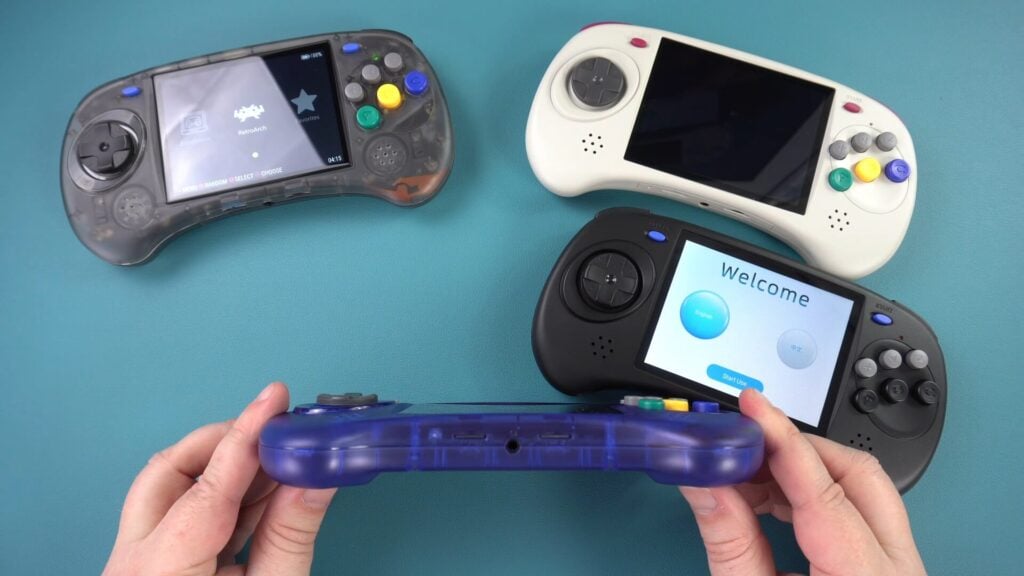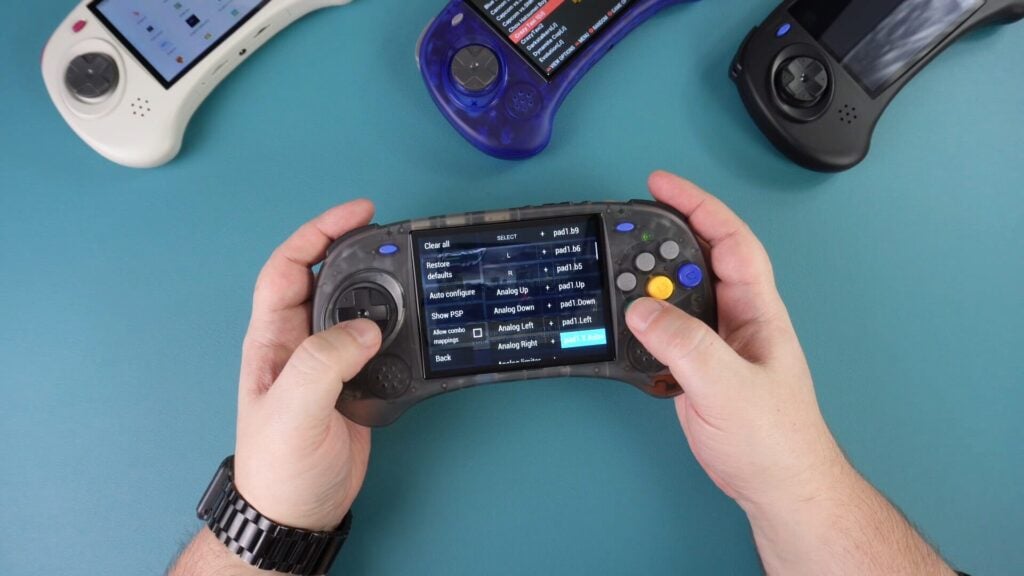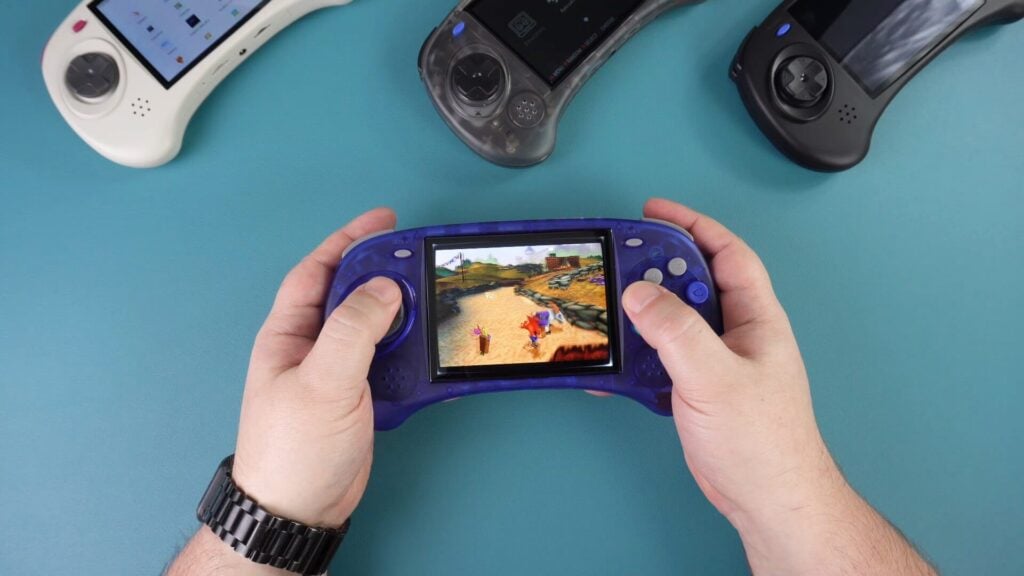Anbernic RG ARC-S & ARC-D gjennomgang
-
Design
(5)
-
Build Quality
(4.5)
-
Display
(4.5)
-
Performance
(4.5)
-
Features
(4.5)
-
Software
(4.5)
Sammendrag
Anbernic RG ARC-S og ARC-D er håndholdte retro-spillkonsoller med Linux og dual boot med Android OS-alternativer og et flott design inspirert av SEGA Saturn-kontrolleren.
Totalt sett
4.6Brukeranmeldelse
( votes)Fordeler
- Flott design inspirert av SEGA Saturn-kontrolleren
- Valg mellom Linux eller dual boot med Android
- Anbernics beste D-Pad hittil!
- 4-tommers skjerm passer helt inn på fronten av den håndholdte enheten
Ulemper
- RK3566-prosessoren ser veldig gammel ut nå
Anbernic RG ARC-S og Anbernic RG ARC-D går tilbake til alternativene for enkel Linux og dual boot med Android, som vi først så i Anbernic RG353V- og VS-modellene. Er det noe som har blitt bedre som gjør det verdt å bruke litt ekstra på ARC-D med dual-boot? Fortsett å lese vår Anbernic RG ARC-S & ARC-D-anmeldelse, så skal vi gi deg beskjed.
Anbernic RG ARC-S & ARC-D gjennomgang video
Utpakking av Anbernic RG ARC-S og ARC-D
Vi starter vår Anbernic RG ARC-S & ARC-D-anmeldelse med å pakke ut esken. Innholdet i esken for begge retro-spillhåndholdte er det samme bortsett fra fargene. Først har vi selve Anbernic ARC som vi vil sjekke ut mer detaljert om kort tid.
Det er en USB Type-C-ladekabel. Deretter har vi et 128 GB eller 256 GB micro SD-kort, dette går inn i det andre sporet på enheten. Det første sporet har et 16 GB-kort for Linux OS. Det er en brukerhåndbok som er på engelsk og kinesisk på den andre siden. Og sist, men ikke minst, er det en skjermbeskytter og våtservietter for når du bruker den.
Oversikt over Anbernic RG ARC
I den neste delen av vår anmeldelse av Anbernic RG ARC-S & ARC-D tar vi en nærmere titt på de to modellene. Anbernic RG ARC måler rundt 19,1 x 8 x 2,2 cm (7,5 x 3,14 x 2,2 tommer) og veier 242 g. Anbernic RG ARC-S er tilgjengelig i gjennomsiktig svart og blå farger, og Anbernic RG ARC-D er tilgjengelig i svart og grå.
Kontrolleren er inspirert av den klassiske SEGA Saturn-kontrolleren, med D-Pad og seks knapper på forsiden. Start-knappen og Select-knappen er plassert øverst på hver side av skjermen.
Skjermen er en 4,0″ IPS-skjerm med en oppløsning på 640×480, noe som er perfekt for retrospill. Den bærbare retrospillkonsollen ARC-D har berøringsskjerm siden den bruker Android OS.
Langs toppen er det de vanlige venstre og høyre skulderknappene. Det er to USB Type-C-porter, én for data og én for lading. Det er en Mini HDMI-port for utgang til en TV eller skjerm. Deretter har vi en funksjonsknapp for å åpne menyer, en volumknapp og en strømknapp.
På undersiden er det to spor for micro SD-kort. Det første sporet har allerede et 16 GB-kort for Linux OS, og det andre sporet er for et 128 GB- eller 256 GB-kort for lagring av spill.
Anbernic RG ARC Tekniske spesifikasjoner
Vi fortsetter vår Anbernic RG ARC-S & ARC-D-gjennomgang og sammenligner spesifikasjonene og kjører noen benchmarks på Anbernic RG ARC-D bærbar spillhåndholdt som har Android OS.
| Anbernic RG ARC-S | Anbernic RG ARC-D | |
| CPU | RK3566 Quad-Core 64 bit Cortex-A55, hovedfrekvens 1,8 GHz | RK3566 Quad-Core 64 bit Cortex-A55, hovedfrekvens 1,8 GHz |
| GPU | Mali-G52 MP2 | Mali-G52 MP2 |
| RAM | 1 GB LPDDR4 | 2 GB LPDDR4 |
| OPPBEVARING | 16 GB (Linux) 128 GB eller 256 GB (lagringsplass) | 16 GB (Linux) 128 GB eller 256 GB (lagring) 32 GB eMMC (Android) |
| DISPLAY | 4,0-tommers IPS, full visningsvinkel, null avstand OCA full passform / 640*480 | 4,0-tommers IPS med berøringsskjerm, full visningsvinkel, null avstand OCA full passform / 640*480 |
| WIFI | 2.4/5G WIFI 802.11a/b/g/n/ac, | 2.4/5G WIFI 802.11a/b/g/n/ac, |
| BLUETOOTH | Bluetooth 4.2 | Bluetooth 4.2 |
| OS | Linux | Linux Android 11 |
| SPEAKER | Dobbel hornstereohøyttaler av høy kvalitet | Dobbel hornstereohøyttaler av høy kvalitet |
| BATTERI | Li-polymer 3500 mAh, varer i opptil 6 timer, støtter C2C-lader | Li-polymer 3500 mAh, varer i opptil 6 timer, støtter C2C-lader |
Android OS-benchmarks
ARC-D kjører som nevnt Android OS. Vi utførte noen benchmarks for å se ytelsen sammenlignet med andre lignende Android-enheter, inkludert RG353V og RG353M.
I 3DMark Slingshot-testen så vi en merkbar forskjell i ytelse sammenlignet med andre enheter som bruker samme prosessor.
På Geekbench var enkelt- og flerkjernescorene også litt høyere på de samme brikkesettmodellene.
Og for Antutu så vi igjen en merkbar ytelsesøkning i forhold til de samme brikkesettene.
Vi ser en generelt høyere ytelse på Anbernic RG ARC-D sammenlignet med RG353V- og RG353M-håndholdte enheter som bruker RK3566-brikkesettet. Men det er den brikken som gir lavest ytelse i våre benchmarks, med store forskjeller sammenlignet med andre, om enn dyrere, håndholdte enheter som AYN Odin 2, som er den som gir klart best ytelse.
Oversikt over Linux
Menyoversikt
I den neste delen av vår gjennomgang av Anbernic RG ARC-S og ARC-D tar vi en nærmere titt på Linux OS. Både Anbernic RG ARC-S og ARC-D har Linux OS tilgjengelig for bruk. Dette er et forhåndskonfigurert oppsett med brukergrensesnitt i stil med emuleringsstasjonen. Oppsettet er litt annerledes på grunn av temavalget, men du kan endre til et mer visuelt oppsett i innstillingene.
Emulatormenyen er for emulatorer som er uavhengige av RetroArch, blant annet SEGA Naomi Arcade, Dreamcast, Saturn og PlayStation Portable.
Og RetroArch-menyen er en mer fullstendig liste over kompatible emulatorkjerner som inkluderer forskjellige håndholdte enheter som Game Gear og WonderSwan, 8-bits konsoller, inkludert Master System, i mellom med PC Engine, og 16-bits systemer som Genesis / Mega Drive. Du kan også finne arkadesystemer og emulatorer, inkludert CPS, MAME, Neo Geo osv.
Du kan bla gjennom de tilgjengelige systemene med D-Pad, velge ett for å gå til systemets spilleliste og velge et spill du vil spille.

Når du kjører et spill fra RetroArch-utvalget, og noen av de individuelle emulatorene, kan du trykke på Function-knappen for å få opp menyen. Spesielt for RetroArch kan du få tilgang til alle de vanlige funksjonene som lagring og lasting, ta skjermbilder, starte spillet på nytt, endre kontrollene og så videre.
Vi har også lagt merke til at mange av emulatorene nå har en ramme. Avhengig av systemet kan du ha en veldig liten TV-lignende design, og på håndholdte en større for å fylle ut den tomme plassen. Det er en fin touch fra Anbernic, og jeg tror det er første gang de har gjort dette som standard på sine vintage-spillhåndholdte.
Mangelen på analoge pinner
Som en merknad angående kontrollene, på grunn av at det ikke er noen analog spak på begge modellene, kan noen spill kreve dette for at spillet skal kunne spilles.
I noen tilfeller kan du ganske enkelt gå inn i emulatorinnstillingene og omdefinere analogene til å bruke D-Pad. Men hvis spill bruker separate digitale og analoge kontroller for funksjoner, vil dette føre til en konflikt og ikke fungere. Dette gjelder naturligvis både Linux og Android OS.
Emulatorens ytelse
Alt i alt fungerer alle emulatorene veldig bra. Du vil ikke ha noen problemer med 8- og 16-systemene. Hvis du går opp et nivå til PlayStation 1 og Dreamcast, kan du se sporadiske fall i bilder på PS1, men ikke noe stort. Og for Dreamcast ser vi blandet ytelse, noen spill fungerer bra, mens andre kjører rundt halvparten av hastigheten.
Og når vi går over til nyere systemer. For Drastic-emulatoren får vi en anstendig ytelse. Husk at Anbernic RG ARC-S-modellen ikke har støtte for berøringsskjerm, så du kan få problemer med spill som krever det.
For PSP fant vi igjen veldig blandet ytelse avhengig av spillet. Med vårt favorittspill God of War får vi lave bildefrekvenser under 30-tallet, og litt bildehopping vil gjøre det mer spillbart. Langt mindre krevende spill vil kjøre bedre, men jeg ville ikke kjøpt denne hvis PSP er ditt hovedvalg av spill å spille på den.
Oversikt over Android OS
Etter Linux OS-oversikten tar vi en titt på Android OS som en del av anmeldelsen av Anbernic RG ARC-S & ARC-D.
OS-oversikt
Anbernic RG ARC-D har dual boot til Android OS, som du får tilgang til ved å ta ut Slot 1-kortet. Ved første oppstart får du opp en velkomstskjerm som tar et par minutter å konfigurere alle appene osv.
Det er ingen støtte for Google Play Store, men du kan laste ned og installere appene dine, eller installere fra SD-kortet hvis du ønsker det. Vi hadde ingen problemer med å oppdatere noen av emulatorene.
Den første skjermen er tom, men du kan skyve opp skjermen for å vise listen over apper og dra og slippe favorittene dine til hovedskjermen.
Her har du to alternativer for å få tilgang til emulatorene. Den raske måten med Anbernic-frontend, eller den lengre måten som innebærer en del oppsett.
Den raske måten innebærer å skyve nedtrekksmenyen og trykke på Game Mode-ikonet. Dette vil laste inn Anbernic-frontend, og første gangs innlasting vil ta lengre tid ettersom den skanner lagringskortet ditt etter spill.

Når den er lastet inn, har den sortert spillsamlingen din i de respektive systemene. Deretter kan du bla gjennom med berøringsskjermen eller D-Pad og kjøre et spill. I likhet med Linux bruker den en blanding av RetroArch og individuelle emulatorer for de systemene som støttes.
Det andre alternativet er litt mer komplisert og vil vanligvis kreve at du i det minste konfigurerer kontrollene og spillbanen for hver emulator. Dette kan være nyttig for emulatorer som Anbernic-frontend ikke støtter. Men ellers ville jeg valgt Anbernic-frontend.
Emulatorens ytelse
Ytelsen er i hovedsak den samme for 8- og 16-bits systemer. Du vil ikke se noen forskjell i ytelse der. Dette er omtrent det samme for PlayStation 1-emulering, kanskje et og annet bildebortfall her og der, men ikke noe som ødelegger spillet. Dreamcast-emulering er omtrent på samme ytelsesnivå som vi så på Linux.

For Drastic-emulatoren får vi samme ytelse på Linux, noe som er veldig bra. Med støtte for berøringsskjerm på denne klassiske spillkonsollen blir mange flere spill spillbare, noe som definitivt er en bonus.
For PSP vil du se mindre forskjeller i ytelse sammenlignet med Linux-versjonen. Noen spill kjører litt jevnere, men med denne prosessoren kommer du ikke til å oppleve mirakler.
Det finnes også Dolphin- og AetherSX2-emulatorer, men heller ikke med denne prosessoren vil du ikke få noe annet enn de mest grunnleggende spillene til å kjøre på spillbare nivåer.
Avsluttende tanker
Vi oppsummerer tankene våre nå i vår Anbernic RG ARC-S & ARC-D anmeldelse. Anbernic RG ARC klassisk spillhåndholdt er en fin forandring fra de vanlige vertikale og horisontale mursteinstildesignene. Jeg liker den Saturn-kontrollerinspirerte designen mye. Den føles fin i hendene, og skjermen tar opp all tilgjengelig plass på fronten. Kontrollene er flotte, spesielt D-Pad føles utmerket, det er den beste D-Pad så langt fra Anbernic,
Når det gjelder hvilken modell du bør kjøpe, Anbernic RG ARC-S eller Anbernic RG ARC-D… Det er rundt £ 10 / $ 10 prisforskjell, så det er ikke et enormt beløp. Men hvis du har et budsjett, kan det være verdt å spare litt penger.
Begge modellene har generelt sett samme ytelse på tvers av alle emulatorene. Anbernic RG ARC-D har mer RAM og intern lagringsplass, men dette er hovedsakelig for bruk av Android. Berøringsskjermen kan være en viktig faktor hvis du foretrekker å navigere med den, eller for å spille flere spill med Drastic-emulatoren.
Med Android får du også noen flere emulatorer. Men disse er av det mer avanserte slaget og egner seg ikke så godt for denne prosessoren. Du har imidlertid mulighet til å laste ned andre emulatorer som ikke er inkludert, for eksempel for datamaskiner som Amstrad CPC eller Commodore 64.
Hvis du har et budsjett, kan du gå for Anbernic RG ARC-S bærbar spillhåndholdt, du kan spare deg for noen få dollar og få den samme standardopplevelsen. Personlig ville jeg i dette tilfellet gått for Anbernic RG ARC-D, for litt ekstra får du en god del mer. Hvis du ikke har noe imot å bruke litt tid på å laste ned og konfigurere nye emulatorer som du ellers ikke ville fått med ARC-S.
Du kan lese mer og bestille Anbernic RG ARC-S her og Anbernic RG ARC-D her. Du kan se vårt utvalg av retro-håndholdte spillkonsoller her.
Og hvis du planlegger å kjøpe enten Anbernic RG ARC, kan du ta en titt på vår komme i gang-guide som dekker alt fra oppsett, til å legge til ekstra spill og mye mer!
Takk for at du leste vår Anbernic RG ARC-S & ARC-D anmeldelse, vi håper du har funnet den nyttig. Hvis du har spørsmål om denne håndholdte, vennligst gi oss beskjed i kommentarene. Takk skal du ha!
[azp_custom_product id="6″]



























